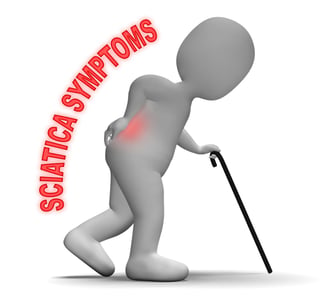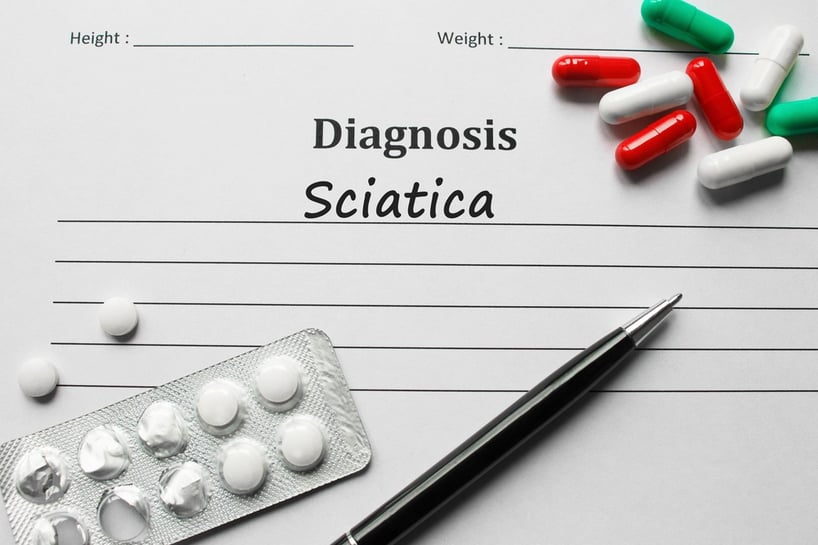Sciatica: What Is It, Signs and Symptoms
May 2nd, 2017 | 4 min. read


Sciatica is a condition you’ve probably heard about in middle-aged and older people. It’s a painful, annoying condition that often manifests by an inability to get comfortable in a chair. No matter how you shift your weight, cross or uncross your legs, or pad your seat, you can’t get comfortable. Your buttocks and leg hurt, but only on one side of your body. Sometimes your feet and toes feel tingly and numb. You may even feel shooting, electrical pains going up and down the back or the outside of your thighs and calves.
If you’re experiencing these symptoms, perhaps along with some weakness in the affected leg, you may have sciatica.
What Is Sciatica?
Sciatica is a term used to describe the symptoms you experience if you have a pinched or compressed sciatic nerve on one side of your body. The two sciatic nerves, one on each side of the body, run down the lengths of your legs. The sciatic nerves are the human body’s largest and longest nerves. At their roots they begin as a bundle of five individual nerves on each side of the spine. Two of these nerves exit the spine between lumbar and sacral segments of the lower back (between L4 and L5 vertebrae, and between L5 and S1). The other three nerves exit through the sacral foramen (tiny holes in the bones that allow nerves to pass through) of the S1, S2, and S3 vertebrae.
These five nerves join up at the piriformis muscle deep in the buttocks. Here, they become one single, large sciatic nerve that runs through the buttocks and down the back of each leg, all the way down to the foot.
These two sciatica nerves connect the spinal cord to the leg muscles of the thigh and lower leg, including the outside of the thigh and the hamstrings (where sciatica pain symptoms are often felt). Each sciatica branches out to the entire leg and foot, and is responsible for controlling the motor function of each leg, as well as the sensory input (pain, itching, numbness, soreness, etc.).
What Causes Sciatica Pain?
 Unless you’re an athlete, the most likely cause of your sciatica pain is the pinching of a highly sensitive sciatic nerve root by a nearby herniated or slipped disc in your lower back (lumbar spine). When one spinal vertebra slips over another, the protruding segment of bone can impinge one of the sciatica nerve roots in the area. This pinching creates inflammation and irritation, which is responsible for a set of symptoms you’ll recognize as prickling, numbness, pain, and possibly weakness of the leg and foot.
Unless you’re an athlete, the most likely cause of your sciatica pain is the pinching of a highly sensitive sciatic nerve root by a nearby herniated or slipped disc in your lower back (lumbar spine). When one spinal vertebra slips over another, the protruding segment of bone can impinge one of the sciatica nerve roots in the area. This pinching creates inflammation and irritation, which is responsible for a set of symptoms you’ll recognize as prickling, numbness, pain, and possibly weakness of the leg and foot.
Because each sciatic nerve branches out into smaller nerves throughout the leg and foot, you may feel these symptoms in different places. Not every person with sciatica has the exact same set of symptoms. For example, some may feel pain and numbness in the feet and toes; others may have shooting pains down the outside of the thigh.
More often than not, if your sciatica symptoms are caused by a slipped disc they will resolve on their own with minimal treatment. However, since sciatica is a symptom, not a disease, it can be a sign of another underlying spinal condition that may need specific treatment: for example, sciatica can be caused by degenerative disc disease, spinal stenosis, or spondylolisthesis.
If you have an underlying issue like degenerative damage to the spine or a narrowing of the spinal column, you’re likely to have other symptoms in addition to the sciatica symptoms (for example, you may also experience stiffness of the lower back, spasms, or difficulty twisting from side to side).
The bottom line: if you have sciatica pain, weakness, or numbness, don’t assume it’s a minor annoyance that will go away on its own; a visit to a doctor is needed to diagnose your symptoms and to gauge whether a more serious problem may be the cause of your nerve impairment.
Risk Factors/Causes
Risk factors and specific causes of sciatic nerve impingement include:
- Herniated or slipped discs
- Spinal stenosis (narrowing of the spinal canal)
- Spondylolisthesis (slipping of one vertebra onto another)
- Disc degeneration, due to arthritis or other spinal conditions
- Bone spurs
- Tumors
- Age
- Pregnancy
Sciatica Symptoms
Most of the time, sciatica affects only one side of the body—one leg, one buttock, or one hip. Your symptoms may be  persistent and get worse over time, or they can be intermittent. They can also range from occasionally annoying to excruciating and distracting, maybe even debilitating.
persistent and get worse over time, or they can be intermittent. They can also range from occasionally annoying to excruciating and distracting, maybe even debilitating.
Sciatica symptoms include:
- Weakness in the leg or knee. You may at times have trouble moving the affected leg or foot.
- A constant, shooting, burning, or electric-like pain that originates in or near the buttocks and radiates down the back of the leg, sometimes to your toes.
- Leg numbness and tingling which may extend to your foot.
- A sudden, shooting leg pain or tingling when you move quickly (for example, when you sneeze).
- Discomfort in the leg and buttocks: you can’t sit comfortably, or get comfortable, in any position; all seated positions are painful and irritating.
- Loss of bladder or bowel control. In severe cases, excess pressure put on the sciatic nerve may lead to irreversible damage to these functions. If you experience a noticeable uptick in the number of accidents you’re having (or an urgent, uncontrollable need to go to the bathroom—frequently), you should see a doctor immediately. The cause of your sciatica may be advanced enough to require surgery as soon as possible in order to relieve the pressure your spine is putting on the sciatic nerve.
Sciatica Diagnosis

Sciatica can be diagnosed by your physician or orthopedist using a simple in-office test. Your doctor will have you lie on your back with your legs outstretched. She’ll then raise the affected leg to between 30 and 70 degrees.
If your typical pain symptoms occur—shooting pain, numbness, or tingling, running from the buttocks down the back of your leg to your feet—you’re likely to have a pinched sciatic nerve. The doctor can tell from this maneuver that stretching the nerve is triggering your symptoms, indicating there’s a compression at the nerve’s root (in your lower back/hip area).
In addition to this, most orthopedists can get a sense, based on the location and nature of your symptoms, exactly where the nerve impingement is occurring. For example, if the top of your foot is numb and you have trouble extending your big toe (a condition commonly referred to as foot drop), your L5 sciatica nerve root may be inflamed or compressed.
If you have other lower back or neck symptoms, after this exam your orthopedist may want to run additional tests to check for injuries to your spinal column. Spinal degeneration or damage may necessitate a different pain management and treatment plan, or possibly even surgery. However, most of the time, sciatica can be treated easily at home.
What Next?
The majority of sciatica cases (75% or more) resolve on their own with time: for example, a slipped disc can sometimes move back into place spontaneously. Sciatica cases that resolve naturally like this tend to do so in about 90 days. Pain medications, NSAIDs (anti-inflammatory medications), physical therapy exercises, or a steroid injection can help to speed up the process.
If symptoms don’t resolve through these means within three months, you may need to talk to your othopedist about surgery.
Contact Coastal Orthopedics in Corpus Christi, Texas today to schedule an appointment to be evaluated for Sciatica at (361) 994-1166.
Article written by: Rob Williams, MD
Dr. Williams has been practicing orthopedic surgery in Corpus Christi since 1998. After graduating from Texas Tech hereceived his medical degree from the University of Texas at San Antonio. At the prestigious Campbell Clinic located at the University of Tennessee, Dr. Williams completed not only an Orthopedic Surgery Residency, but an additional year of Fellowship Training in Spine Surgery. Dr. Williams is dedicated to creating an excellent patient experience in the office or in the surgery suite.
Topics:


